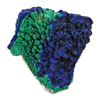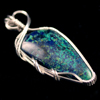Azurite is a soft, deep blue copper mineral
produced by weathering of copper ore deposits,
it has been known since ancient times. The blue
of azurite is exceptionally deep and clear, and for
that reason the mineral has tended to be
associated since antiquity with the deep blue
color of low-humidity desert and winter skies.
The modern English name of the mineral reflects
this association, since both azurite and azure are
derived via Arabic from the Persian
LAZHWARD, an area known for its deposits
of another deep blue stone, lapis lazuli ("stone of
azure").
Azurite was used as a blue pigment for centuries.
Depending on the degree of fineness to which it
was ground, and its basic content of copper
carbonate, it gave a wide range of blues. It has
been known as Mountain Blue or Armenian
Stone, in addition it was formerly known as
Azurro Della Magna (from Italian saying). When
mixed with oil it turns slightly green. When mixed
with egg yolk it turns green-gray.
True lapis lazuli was chiefly supplied from
Afghanistan during the Middle Ages while
azurite was a common mineral in Europe at
the time. Sizable deposits were found near
Lyons, France. It was mined since the 12th
century in Saxony, in the silver mines located
there.
Azurite is used occasionally as beads and as
jewelry, and also as an ornamental stone.
However, its softness and tendency to lose
its deep blue color as it weathers limit such
uses. The intense color of azurite makes it a
popular collector's stone. To help preserve
the deep blue color of a pristine azurite
specimen, collectors should use a cool, dark,
sealed storage environment similar to that
of its original natural setting.

